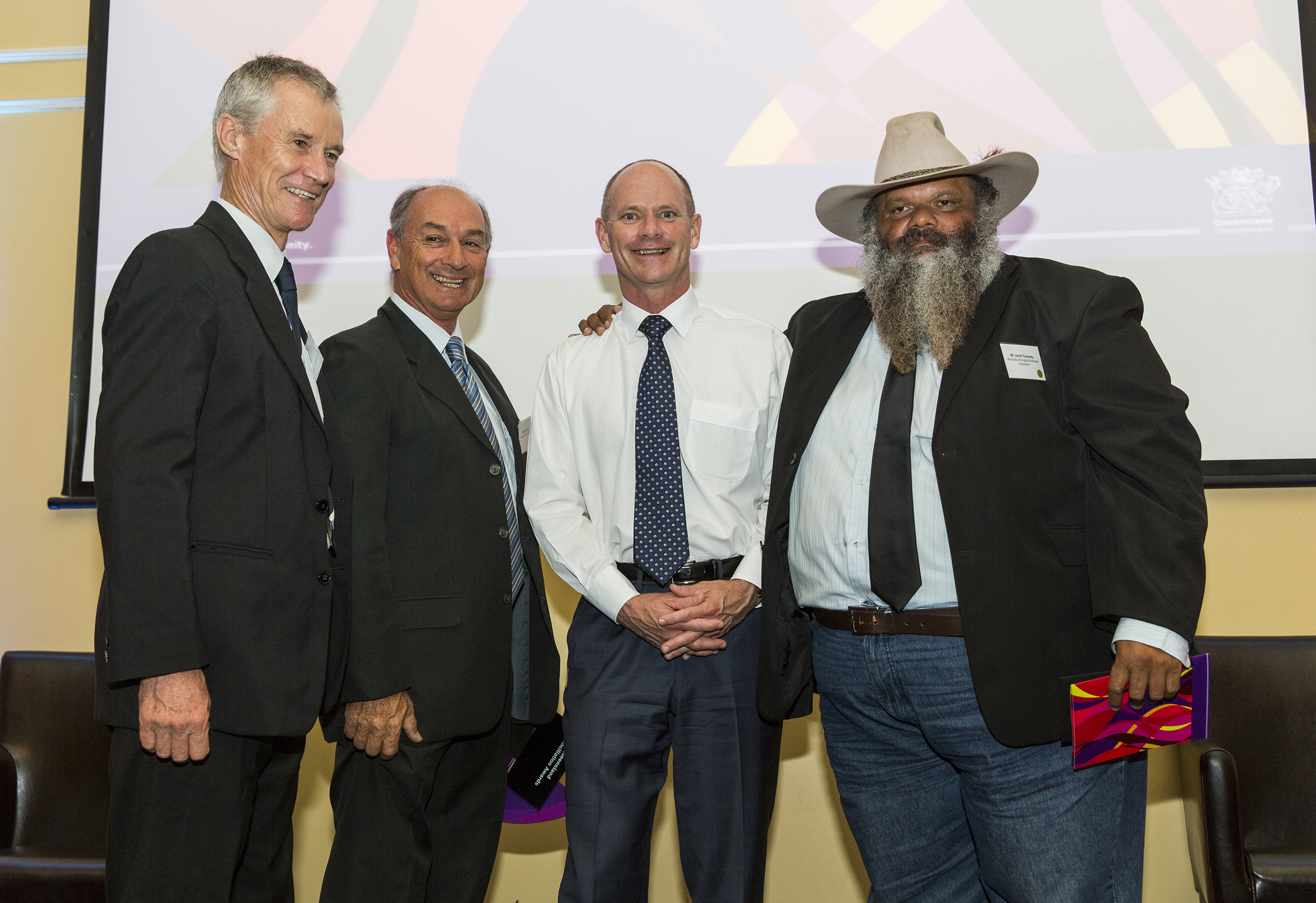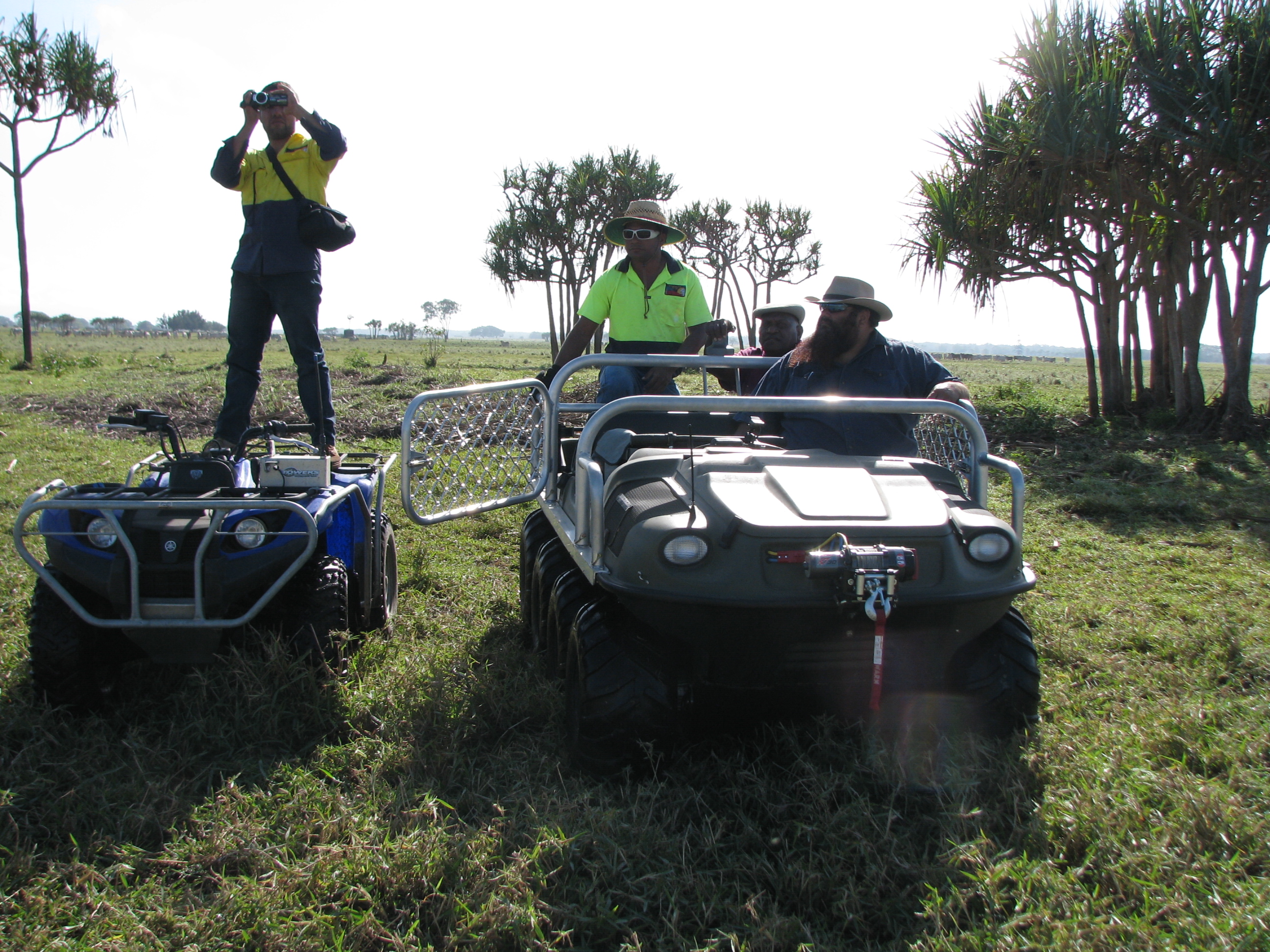In 1999 the Nywaigi people, through the Nywaigi Aboriginal Land Corporation, purchased Mungalla Station, an 880 Ha cattle property that represents a small part of their ancestral lands and waters. Sitting adjacent to the World Heritage Great Barrier Reef lagoon and the IUCN-listed Halifax Bay Wetlands National Park, Mungalla is an enchanted bit of country.
Once the Nywaigi were back on that country though, they found there were some issues.
Unfortunately, in the years before the Nywaigi took back control of Mungalla, the wetlands on the station had become degraded by weed invasion, agricultural run-off and modifications that were made to the natural water flows in the area.
The Nywaigi are looking to turn the condition of the station around and restore Mungalla to a state that meets the cultural, environmental and financial needs of the Nywaigi owners and the broader community. To this end they have developed the Mungalla Wetlands Management Strategy.
Nywaigi managers surveying the wetlands. Image: Mike Nicholas
CSIRO has been working with the station managers since 2006 as a trusted adviser to help carry out this vision and establish a resilient ecosystem that supports diverse native species. Together they secured funding through the Australian Government’s Biodiversity Fund in 2012 for a five year project that will restore natural water flows, manage invasive plant species and revegetate important riparian corridors.
A crucial aspect of the recovery effort is to remove an artificial bund that prevents water movement between freshwater and saline environments. This will restore natural tidal flows and water exchanges to the wetland system and will allow for the recovery of a fish passage into and out of the wetlands. The tidal flows of brackish water will also help with the control of salt intolerant invasive plant species. CSIRO will manage this process and will be monitoring vegetation and water quality using novel aerial image capture techniques, before and after saline intrusions into the wetland.
On the weed front, the main offender is Hymenachne, a noxious Weed of National Signficance. It was first introduced to the area in the 1980s as a forage plant for cattle but it went feral, choking out the waterways and out-competing native vegetation. The station managers are making progress on managing this weed and others through a regime of herbicide spraying and burning. It is hoped that reducing weed abundance will allow diverse native plant species to return.
- Extent of Hymenachne in the wetlands. Image: Mike Nicholas
- Controlling Hymenachne with a burning regime
Revegetation is being helped along by the strategic planting of locally-sourced native plants. By involving young people in the revegetation work, the Nywaigi are ensuring knowledge about their country is passed down to younger generations. These activities are re-establishing important habitats and wildlife corridors throughout the wetlands, which will benefit native fauna, particularly birds. Diverse wetland plant communities could provide ideal habitats for nationally threatened and migratory bird species such as jabiru, brolga and magpie goose.
The revegetation work provides an opportunity to pass on knowledge to the younger generations. Image: Jacob Cassady
This work ensures that the cattle and tourism enterprises run by the Nywaigi owners on the station are sustainable and meet their cultural and economic aspirations. In turn, these enterprises support the ongoing management of this precious wetland.
**UPDATE**
On 27 May 2014 Mungalla Aboriginal Business Corporation and CSIRO won the Queensland Reconciliation Award in the Partnership category for the Mungalla Wetlands Biodiversity Project.

©Roslyn Budd - www.buddphotography.com.au
(L-r) CSIRO’s Tony Grice and Mike Nicholas, Qld Premier Campbell Newman, Jacob Cassidy from Mungalla Aboriginal Business Corporation. Credit: Roslyn Budd






30th May 2014 at 10:22 pm
Very interesting article. Oddly enough this article reminds me of what is going on in the USA with the Florida Everglades and Everglades headwaters. The federal government (i.e. US Army Corp of Engineers, US Fish and Wildlife Service, etc.) and state of Florida (i.e. South Florida Water Management District, Florida Department of Environmental Protection, etc.) is slowing buying back land that was used for agriculture and restoring it back to functional wetlands. Keep up the good work!!!
26th August 2013 at 9:31 am
Given the extent of the weed problem one remedy for the water areas would be to plant a mangrove forest. Even if this was not part on the original plant mix their canopy would shade out the grasses and over time kill off the weeds then use accelerated progression and plant out with other suitable species. Regards Peter Ward Merriwa NSW
26th August 2013 at 5:05 pm
Thanks Peter. The wetlands above the bund are actually freshwater and so the likelihood of mangroves surviving is very remote. But your concept of using shading to reduce weed populations is correct and the current project funded under the Biodiversity Fund is aimed at extensive re-vegetation along riparian fringes. The re-veg work has been underway for 12 months and will continue for another four years. Hopefully the result of that work will result in significant reduction in Weeds of National Significance (WONS) populations.
10th July 2013 at 12:48 pm
Country is sacred to indigenous people, not regarded as “real estate” except by an avarious and spiritually bankruptfew – an unfortunate choice of words in an otherwise interesting article.
10th July 2013 at 2:51 pm
Yes, you’re right about country and thanks for pointing that out. I’ve edited the text to remove confusion. While I was using ‘real estate’ in the colloquial sense, it’s also important to note that the Nywaigi have outright legal tenure over the Mungalla wetlands and operate successful enterprises on their land, which is a source of great pride. For those interested in finding out more about the significance of country to Indigenous peoples, there is a good overview in section 2 of this report: http://www.csiro.au/en/Organisation-Structure/Flagships/Water-for-a-Healthy-Country-Flagship/Water-Resources-Assessment/Water-and-indigenous-people-in-the-Pilbara-Western-Australia.aspx; and a comprehensive account of relationships to country in this online book http://www.environment.gov.au/heritage/ahc/publications/commission/books/nourishing-terrains.html